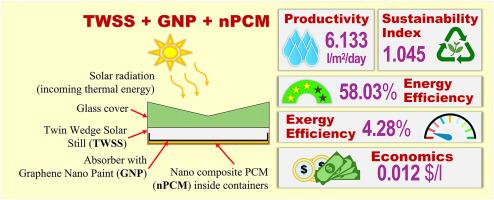Synergistic enhancement of thermal energy conversion in twin wedge solar stills using graphene nano-coated absorber and nano-composite PCM
IF 6.3
2区 材料科学
Q2 ENERGY & FUELS
引用次数: 0
Abstract
Improving the thermal energy conversion efficiency of solar stills is still a key challenge to accelerating clean and sustainable desalination technologies to combat worldwide water scarcity. In this paper, an innovative Twin Wedge Solar Still (TWSS) design is experimentally investigated with two new modifications: (i) a graphene nanoplatelet (GNP)-coated absorber plate to increase solar absorption, and (ii) a mixed nano-composite phase change material (nPCM) based on aluminium oxide (Al2O3) and graphene oxide (GO) for enhanced thermal energy storage. This coupled combination has not been used previously for TWSS applications. The new system exhibits improved performance by enhancing solar absorptivity, thermal conductivity, and storage capacity, resulting in a cumulative productivity of 6.133 L/m2/day. The developed modified system shows 139.4 %, 153.2 %, and 230.7 % greater productivity, energy efficiency, and exergy efficiency compared to the existing TWSS. The evaporative heat transfer rate becomes almost double (235.89 W/m2K compared to 99.15 W/m2K), and the economic cost of distilled water decreases to $0.012/L from $0.024/L for the traditional system. The outcomes verify that the integration of the proposed GNP-coated absorber and GO-Al2O3-based nPCM provides a new and economical path to enhance solar desalination performance, making it a promising strategy for sustainable freshwater production.

利用石墨烯纳米涂层吸收剂和纳米复合相变材料协同增强双楔形太阳能蒸馏器的热能转换
提高太阳能蒸馏器的热能转换效率仍然是加速清洁和可持续海水淡化技术以应对全球水资源短缺的关键挑战。本文对一种创新的双楔形太阳能蒸馏器(TWSS)设计进行了实验研究,并进行了两种新的改进:(i)石墨烯纳米板(GNP)涂层吸收板以增加太阳能吸收,以及(ii)基于氧化铝(Al2O3)和氧化石墨烯(GO)的混合纳米复合相变材料(nPCM)以增强热能储存。这种耦合组合以前没有用于TWSS应用程序。新系统通过提高太阳能吸收率、导热性和存储容量,提高了性能,累计生产率为6.133 L/m2/天。与现有的TWSS相比,改进后的系统的生产率、能源效率和火用效率分别提高了139.4%、153.2%和230.7%。蒸发换热率从99.15 W/m2K提高到235.89 W/m2K,几乎翻了一番,蒸馏水的经济成本从传统系统的0.024美元/L降低到0.012美元/L。结果表明,将gnp涂层吸收剂与go - al2o3基nPCM相结合,为提高太阳能脱盐性能提供了一条新的、经济的途径,使其成为可持续淡水生产的一种有前景的策略。
本文章由计算机程序翻译,如有差异,请以英文原文为准。
求助全文
约1分钟内获得全文
求助全文
来源期刊

Solar Energy Materials and Solar Cells
工程技术-材料科学:综合
CiteScore
12.60
自引率
11.60%
发文量
513
审稿时长
47 days
期刊介绍:
Solar Energy Materials & Solar Cells is intended as a vehicle for the dissemination of research results on materials science and technology related to photovoltaic, photothermal and photoelectrochemical solar energy conversion. Materials science is taken in the broadest possible sense and encompasses physics, chemistry, optics, materials fabrication and analysis for all types of materials.
 求助内容:
求助内容: 应助结果提醒方式:
应助结果提醒方式:


